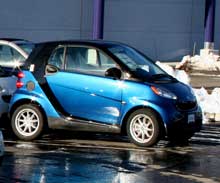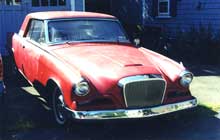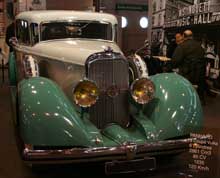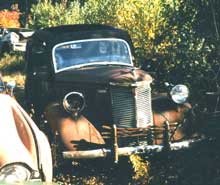Smart Money
It starts at $11,590. Yes, the smart car (the makers prefer lower case) has arrived in America. Actually Roger Penske's Penske Automotive Group has been taking reservations for the smart for about a year; the first cars were delivered last month.
I saw my first smarts in Paris in 2001. A two-passenger urban automobile, the smart was powered by a three-cylinder 600 cc turbo gasoline engine or an 800 cc turbo diesel. Transmission was a 6-speed automanual. Just 98.4 inches long, the smart weighed 730 kg (1609 lb.). A prime attraction of the car, in addition to its economy of operation, was ease of parking, although some drivers are known to take liberties with the rules. In some places they can park perpendicular to the curb, which greatly increases density. Certainly with parallel parking two can park as easily as one; comparison with a recent Citroën puts it in scale. Smart was not the first urban concept; some years ago Renault built a working model of a similar car whose rear wheels folded forward for parking.
All smarts have a tridion chassis that encircles the passenger compartment, painted either black or silver. Body panels, which are removable, come in six colors, though white, black and silver seem most popular. Some decorative touches are occasionally seen, and the smart has been popular in promotional dress.
For a while there was a four-passenger smart, the forfour, a Mitsubishi-based design made in Holland. The two passenger car, called "fortwo," is made in Hambach, France, by a division of Daimler AG (née DaimlerChrysler, née Daimler-Benz AG). It thus becomes the first French-built car sold in the US since Peugeot left in 1992 (although the cars bear the VIN country code of Germany).
Canada has had smart cars since 2004, and they've proved quite popular. This one was visiting Connecticut in 2006 while being tested by Consumer Reports. Canadians got a diesel version, not sold here. The US models have a 1-liter normally-aspirated Mitsubishi gasoline engine and a five-speed automanual gearbox.
The other day I visited my local (50 miles) smart center, as the dealerships are called. Part of the Inskip megamall in Warwick, Rhode Island, it's modestly hosted in a large Mercedes store. Despite stories that smarts were zooming off the lots into buyers' loving hands, I found seven still in stock. It will be, no doubt, a cult car, not simply economical transportation. Smart money, as it happens, is not the cheapest sticker in town. For less, one can buy a Kia Rio, Hyundai Accent or Chevrolet Aveo (think Daewoo), all Korean four-seaters.
First CarPorter to spot a street smart is VW guru Steve Mierz, our Shoreline Scout. He saw this one in front of the post office in Stony Creek, Connecticut. Its smitten owner had already snapped up an appropriate vanity plate. Need I say more?




